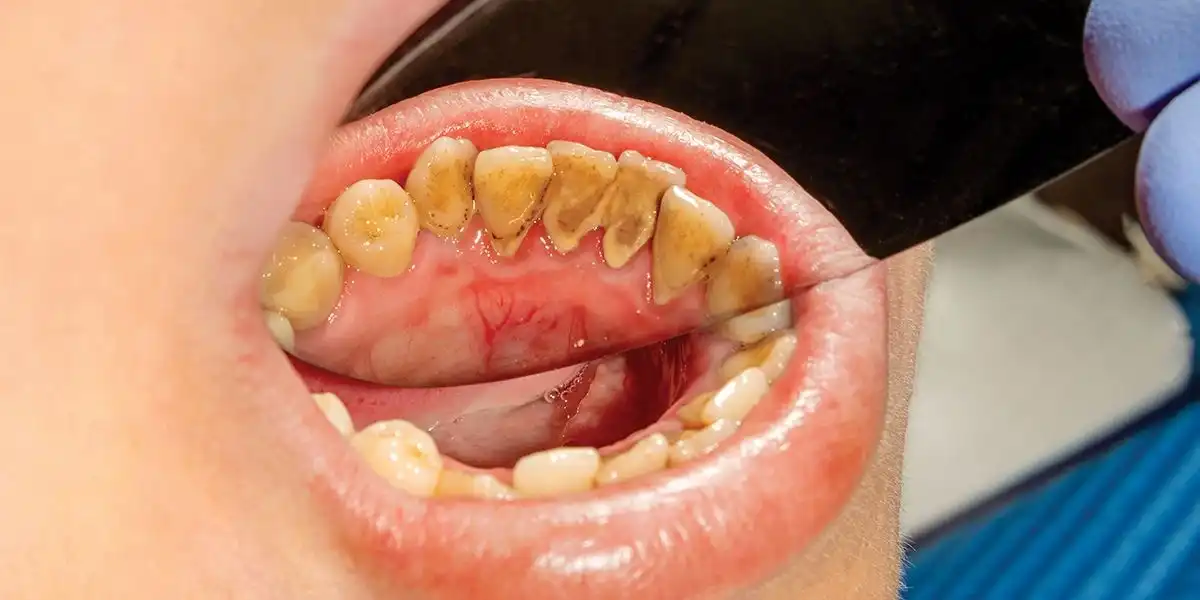How to Prevent Plaque & Tartar Buildup On Teeth


Are you one of those people that tends to get a ton of plaque buildup on teeth at the bottom-front of your mouth?
If your hygienist tends to spend a lot of time cleaning this area during your checkups, or you notice the plaque buildup in the mirror when you’re trying to floss, there’s good news: you’re not alone.
Why Is This A Problem Area?
For starters, cleaning behind your narrow bottom-front teeth is just hard. A large toothbrush head may not be able to get around all the grooves and curves it needs to clean the plaque behind lower front teeth.
But even more significant is your own natural anatomy. Surprise: you have saliva glands right under your tongue, just next to these teeth! That means the plaque buildup in that area will calcify into tartar (hardened plaque) quicker than some of the other parts of your mouth. Brushing and flossing away plaque often helps prevent tooth decay, bleeding gums, gum disease, and other oral health problems. Practice good oral hygiene to keep your teeth and gums healthy.
Bonus info: You also have saliva glands on the outside of your upper-back molars.
Recommended Tools To Fight Plaque Buildup
When it comes to preventing buildup on teeth, physical everyday cleaning is essential. Whether you’re using a soft-bristled toothbrush or an electric version is up to you, but powered toothbrushes are scientifically proven to remove more dental plaque buildup than manual brushes do.
Also, you have to floss. It’s just not an option. Floss or a water flosser is the only thing that’s going to get down between your teeth to clean dental plaque buildup before it turns into tartar.
How To Prevent Plaque Buildup
1) Brush Longer
The amount of time you put into brushing and flossing will have a direct part to play on how much build up you get on your teeth. If you’re just quickly sweeping through with the toothbrush a few times, you’re not going to get the results you want.
Since some of us get more build up on teeth down in the lower-front of our mouths, we need to spend more time (probably an extra 30 seconds) brushing that area. Focus on one or two teeth at a time and really angle the bristles towards your gums. The American Dental Association recommends that you brush your teeth for at least two minutes, twice a day with a fluoride toothpaste.
2) Floss Throughout The Day
Ok. So you should be flossing all of your teeth every day. But when it comes to your lower-front teeth, it’s really beneficial to floss them every time you eat or snack on something.
Floss often. It doesn’t have to take two minutes. After all, you’re only cleaning off that dental plaque buildup on the lower anteriors, not your entire mouth.
Just be sure that even though you’re brushing fast and often, you do it correctly. Really wrap the dental floss around your tooth and hug it as you rub the sides up and down. And since you’re just cleaning a few teeth, floss picks are great for use on the go in your car or storing them in your desk at work.
3) Clean First Thing In The Morning
Some of us are mouth breathers. If that’s the case, we tend to wake up with more plaque on our teeth. Before you go eat breakfast (which will just fuel that sticky biofilm) go ahead and quickly brush your teeth with some water.
Don’t worry, you’re still going to come back and use toothpaste and floss after breakfast but brushing with tap water will get some of that residue away before it feeds on your eggs, toast, or cereal.
4) Avoiding Sugary and Acidic Foods
Eating less acidic and sugary foods is a crucial step in preventing tooth decay. Sugary or starchy foods contribute to the accumulation of food debris in your mouth, which can lead to the formation of harmful plaque. To combat this, choosing sugarless gum can be a helpful alternative. A healthy diet and chewing sugarless gum helps in cleaning your mouth and removing leftover food particles. This practice, along with reducing the intake of sugary foods, is effective in preventing tooth decay and maintaining oral health.
Talk With Your Dentist
Let’s say you’re doing absolutely everything in your power to keep your teeth clean, but you still get a lot of dental plaque buildup on teeth in specific areas of your mouth.
If that’s the case, you and your dentist need to talk about the reality of scheduling more frequent cleanings. Like every 3-4 months, instead of twice a year.
Honesty is the best policy. Share your techniques and products with your dental team, so that they can help you find a realistic way to actively cut down on tartar buildup on teeth.
Bye Bye Plaque And Tartar Buildup!
If you get a lot of plaque behind the bottom of your front teeth, you’re not alone.
However, you do have to be more proactive about keeping the area clean, so that soft plaque biofilm can’t calcify into hard tartar. That means brushing longer, flossing more frequently, cleaning your teeth first thing when you wake up, and being honest with your dentist and hygienist about possibly scheduling professional cleanings more frequently than twice a year.
With a few tips and the extra help of your dental team, you can keep heavy tartar at bay before it leads to something serious like gum disease.

Make your inbox smile!
Subscribe






